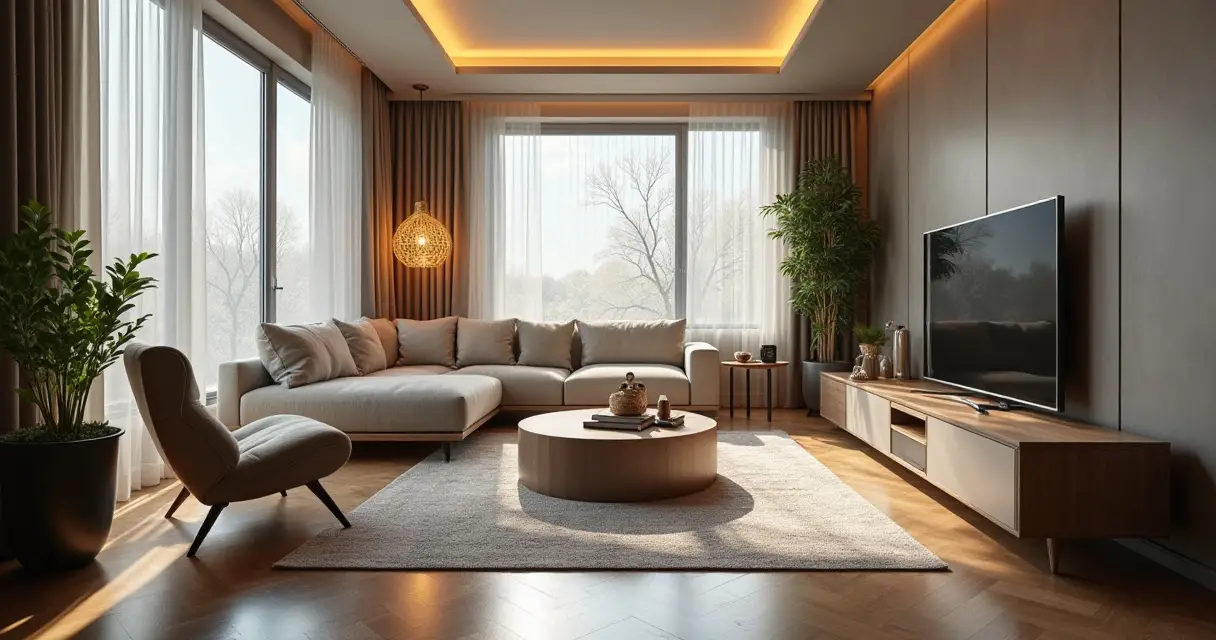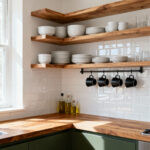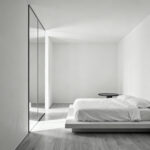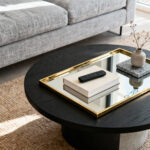Can we talk about why so many living rooms feel… off? It’s my biggest pet peeve. I walk into these otherwise beautiful homes, and the living room looks like a waiting room for a dentist’s office, or worse, a storage unit for furniture that has no other place to go. All the chairs are pushed up against the walls like they’re in time-out, the lighting could be used for an interrogation, and there’s zero personality. It drives me crazy because this is the room you live in. It’s the heart of the home, the backdrop for your life.
The problem is that most advice out there is either fluff or so technical it’s useless. They tell you to “express yourself” but don’t tell you how. After 15 years of photographing and writing about architecture, I’ve learned that a truly great living room isn’t about buying expensive stuff. It’s about a series of deliberate, logical decisions. It’s a formula. So, because you asked, I’m going to break it down for you. No corporate speak. This is the real story on how to create a living room that looks and feels incredible.
Laying the Groundwork: Vision and Layout Planning (Part 1)
Alright, before you even think about paint swatches or that sofa you saw on Instagram, we need to do the groundwork. This is the boring-but-critical part that 90% of people skip, and it’s why their rooms never quite come together. Think of it like the foundation of a house. You can’t build something beautiful and stable on shaky ground. We’re going to define the job of the room, get the scale right, and figure out where people are going to walk and talk.
1. Define Your Living Room’s Primary Function and Purpose
First thing’s first: what is this room actually for? Everyone says they want a living room for “entertaining,” but what does that mean for you? Is it hosting Super Bowl parties with 20 people, or is it quiet cocktails with one other couple? Is it where the kids build LEGO forts and you watch movies on a Friday night? Be brutally honest with yourself. I once had a client who insisted on a formal, all-white living room. A year later, it was a ghost town because her family was terrified to actually use it. They lived their real life in the cramped den.
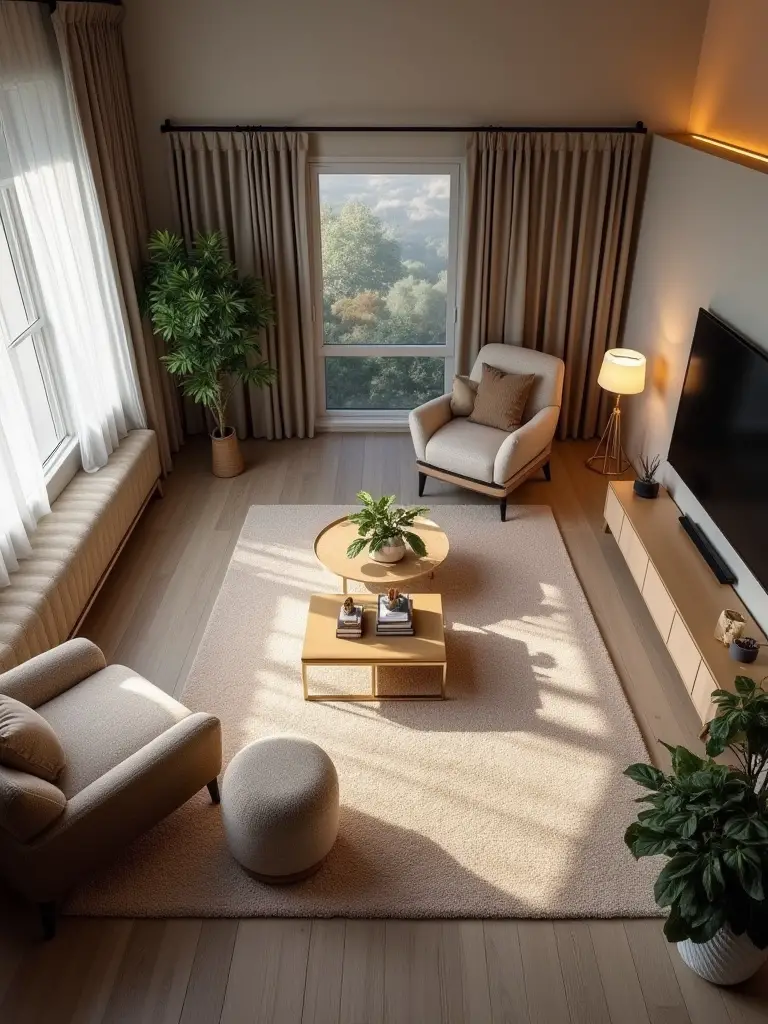
You need to design for the life you have, not the fantasy life you think you should have. Make a list of the top three things that will actually happen in this room, in order of priority. For most people, that’s “watching TV,” “hanging out as a family,” and maybe “a quiet place to read.” That list is your North Star. Every single decision you make from here on out—from the sofa fabric to the number of outlets—has to serve those functions. If it doesn’t, you don’t buy it. Simple.
This functional blueprint is what separates a merely decorated room from a well-designed one, and it’s time to translate that into a visual style.
2. Establish a Cohesive Style Aesthetic for Your Space
You know what people always ask me? “How do I make my style look cohesive?” The answer is simple: stop buying random things you like and start making a plan. You can’t have a sleek minimalist lamp next to a rustic farmhouse coffee table and a bohemian rug and expect it to look like anything other than a garage sale. You need to pick a lane. The best shortcut I know is the mood board. Don’t roll your eyes; this isn’t arts and crafts hour. This is a strategic tool.
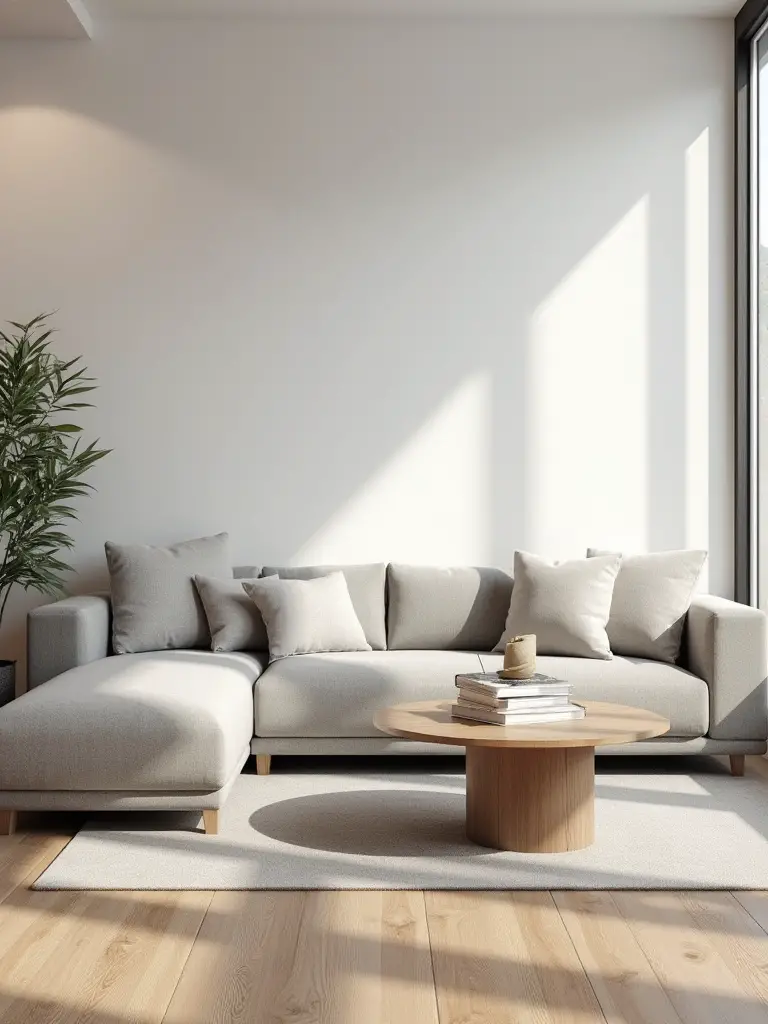
Go on Pinterest or just save images to a folder on your computer. Pin 20-30 living rooms that make you feel something. Then, step back and look for the patterns. Are they all bright and airy? Dark and moody? Full of color? What are the common threads? Is it clean lines, natural wood, velvet textures? You’ll start to see a theme emerge. That theme is your style. Once you have it, you have a filter. When you’re shopping and you see a chair you love, you can ask, “Does this fit my mood board?” If the answer is no, you walk away. It saves you from so many expensive mistakes.
With a clear style in mind, you can now start placing the key pieces, and this is all about creating a space that feels good to move through.
3. Master the Furniture Layout for Optimal Flow and Conversation
This is where my photographer brain kicks in. A room is a composition. You have to think about sightlines, balance, and negative space—the empty parts. The biggest sin in layout is pushing everything against the walls. It creates a dead zone in the middle of the room and makes conversation feel like you’re shouting across a canyon. Your main seating should create a conversational grouping. Sofas and chairs should face each other, not just all bow down to the television.
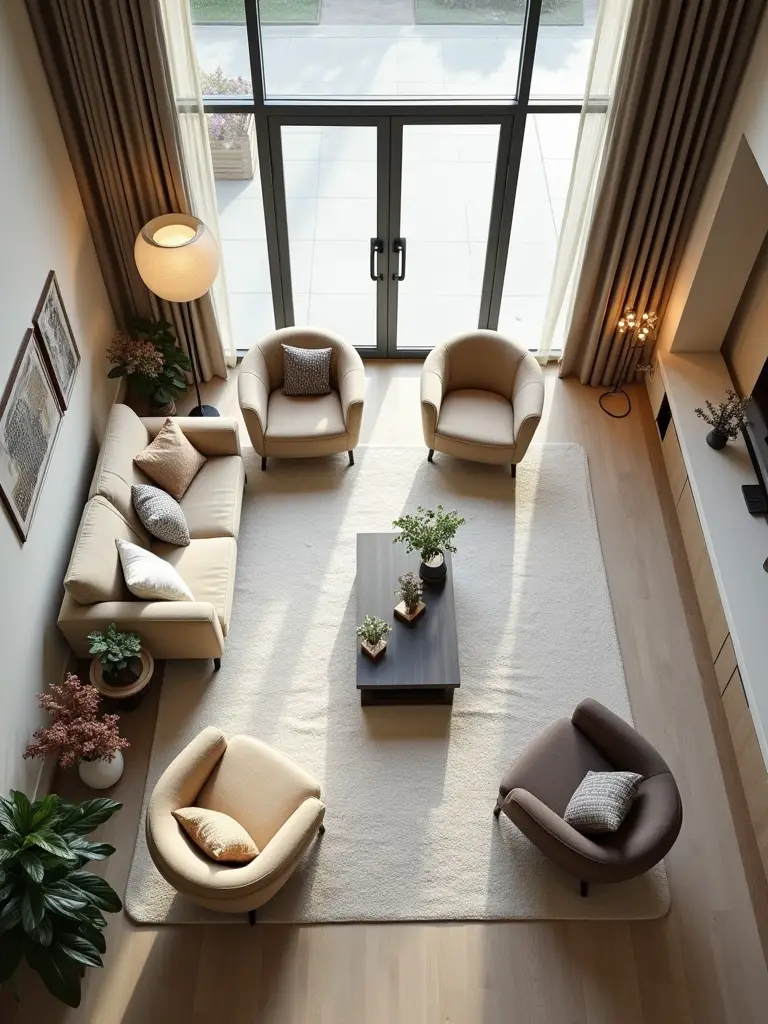
Here’s the trick you absolutely have to do: get out the painter’s tape. Before you buy a single thing, measure the dimensions of the sofa or chairs you’re considering and tape out their footprint on the floor. Live with it for a day. Walk around it. Does it block a major pathway to the door? Do you have to squeeze past it? You need at least 3 feet of clearance for major walkways. Taping it out costs you nothing and can save you from the nightmare of a sofa that doesn’t fit.
Getting the physical layout right is one half of the equation; the other half is creating the right atmosphere, which is all about light.
4. Create a Strategic Lighting Plan for Ambiance and Task
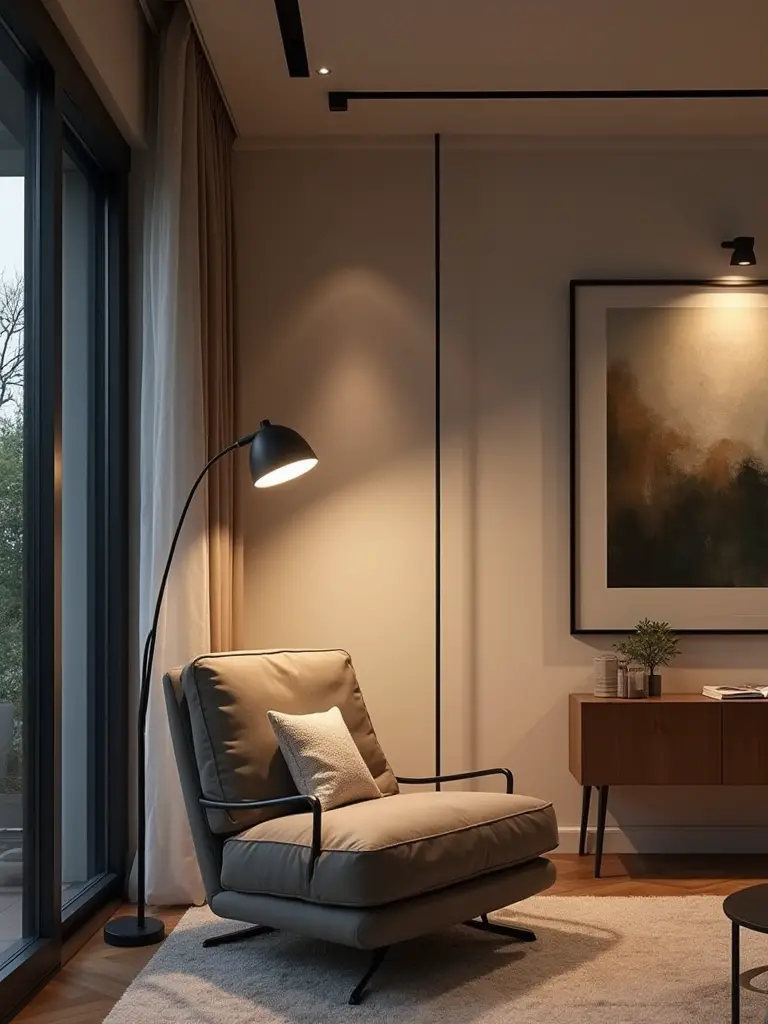
First is your ambient light—the overall glow. This can be your ceiling fixture, but for God’s sake, put it on a dimmer. Second is your task light. This is targeted light for doing stuff, like a floor lamp next to the armchair where you read. Third is your accent light, which is just for making things look cool. Think of a small lamp on a console table or a light that points up at a plant or a piece of art. When you have these three layers working together, you create depth, warmth, and you can change the mood of the room instantly. A dimmer switch is the cheapest, most effective design tool on the planet. Use them everywhere.
Laying the Groundwork: Vision and Layout Planning (Part 2)
Okay, so we’ve planned the room’s purpose and flow. Now we’re setting the stage. This next part is about the biggest surfaces in the room—the walls. The color and finish you choose will have a massive impact on the feel of the space, dictating everything from perceived size to the overall mood. Get this right, and you’ve created a perfect canvas for everything else.
5. Selecting Your Ideal Color Palette and Wall Finishes
The BS everyone tells you is to just “pick a color you love.” That’s a great way to end up with a room that feels jarring and disconnected. The color you choose has to work with your fixed elements—your flooring, the stone on your fireplace, even the view out the window. Your living room doesn’t exist in a vacuum. Start by choosing a palette of three colors based on the 60-30-10 rule. It’s a classic for a reason. 60% of your room will be a dominant color (usually your walls), 30% a secondary color (furniture), and 10% an accent color (pillows, art).
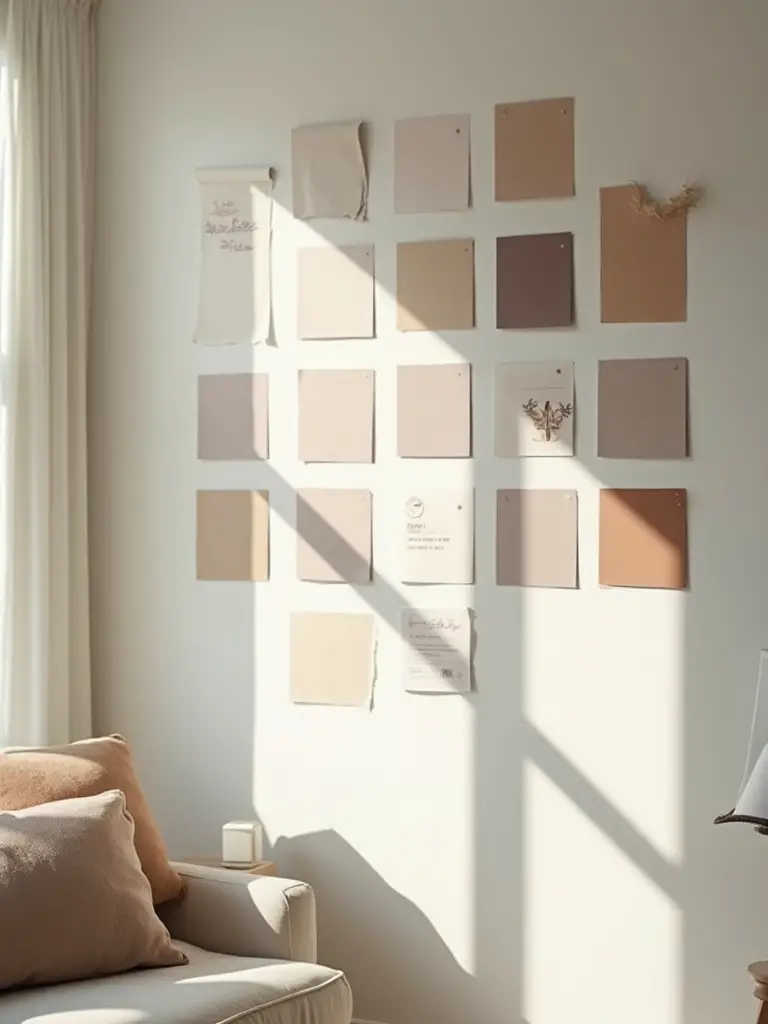
Now for the part you cannot skip: test your paint. Do not, under any circumstances, choose a color from a tiny chip under the fluorescent lights of a hardware store. Paint at least a two-foot-square patch on two different walls and live with it for a few days. See how it looks in the morning light, in the afternoon, and at night with your lamps on. A lovely warm beige in the store can look like a sad, drab yellow in your north-facing room. A professional I know calls this “the most important and most ignored step.” He’s right. Getting the color right is foundational to the room’s success.
Bringing the Vision to Life: Key Furniture & Material Choices (Part 1)
With the foundation laid, it’s time for the fun part: bringing in the furniture and textiles that will define the space. These are the workhorses of your living room, the pieces that will provide comfort, store your stuff, and stand up to daily life. Making smart choices here is the difference between a room that looks good for a year and one that looks good for a decade.
6. Choose the Right Sized Sofa as Your Room’s Centerpiece
The sofa is the undisputed king of the living room. It’s likely your biggest, most expensive, and most used piece of furniture. And its scale will make or break your entire design. The number one mistake I see is a sofa that is comically large for the room. People see a giant sectional in a cavernous showroom and think, “Yes, ultimate comfort!” Then they get it home, and it eats the entire room, blocking pathways and dwarfing everything else. The inverse is also true: a tiny little loveseat floating in a massive room looks pathetic and lost.
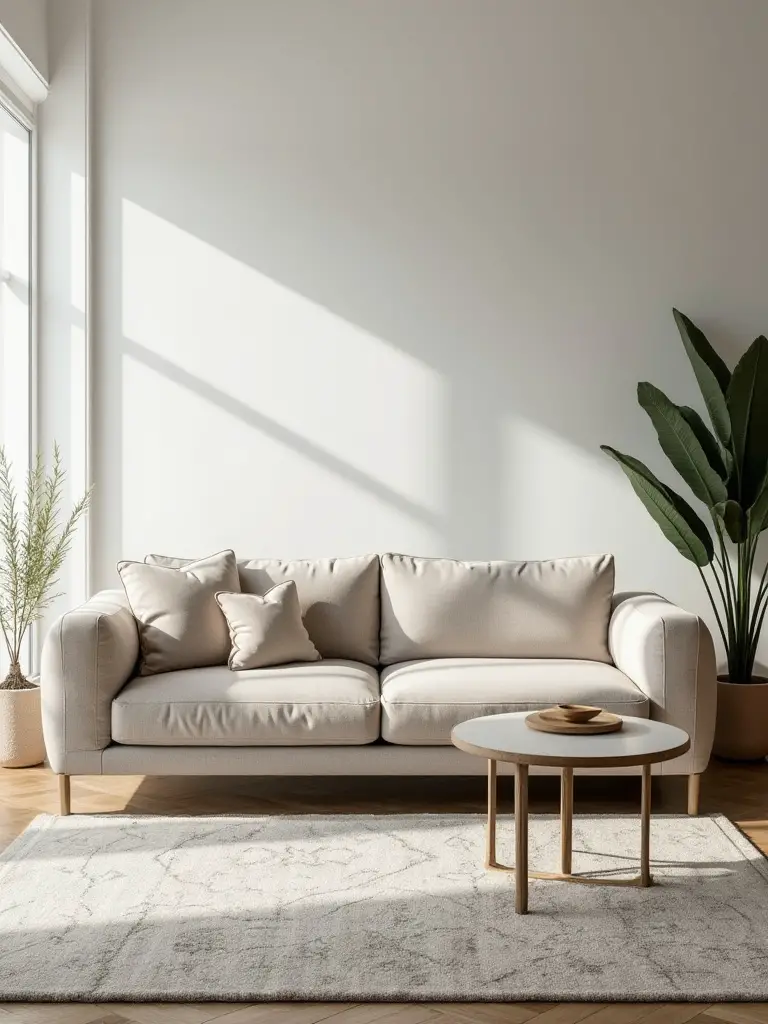
The sofa may be king, but it can’t do its job without smart supporting players, especially when it comes to managing our stuff.
7. Integrate Multi-functional Storage Solutions Smartly
Clutter is the enemy of good design. It creates visual noise that makes a room feel stressful and chaotic, no matter how beautiful the individual pieces are. The secret to a calm, organized living room isn’t having less stuff; it’s having smarter places to put it. This is where Multi-functional Furniture is your secret weapon. Every piece in a small- to medium-sized room should work twice as hard.
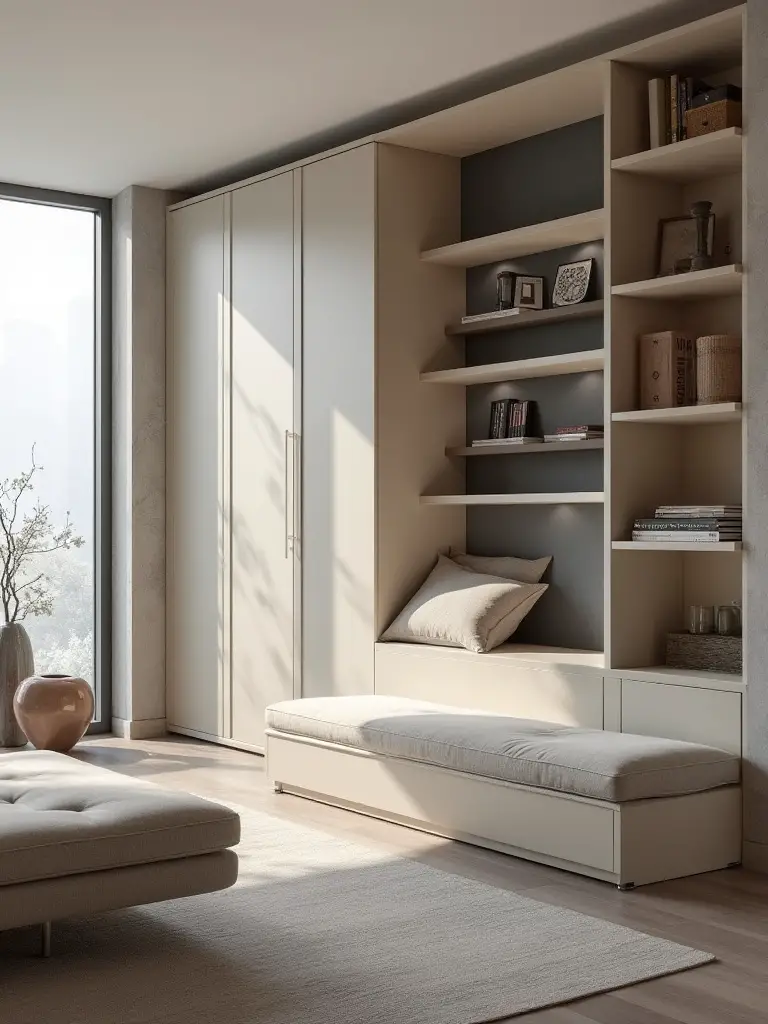
Think coffee tables that are actually storage ottomans where you can stash blankets and board games. Consider media units with closed doors that hide all the ugly electronics and cords. A console table behind the sofa can hold lamps and decor on top, with baskets underneath for toys or magazines. The goal is to have a designated, hidden home for everything that creates clutter. It’s not about being a minimalist; it’s about being a strategist.
With your storage planned, let’s look down at the literal foundation of the room—the floor.
8. Select Durable and Visually Appealing Flooring Options
Flooring is the stage on which the entire drama of your living room unfolds. It’s one of the biggest surfaces in the room, so its color and texture have a massive impact. But here’s the thing: it has to be a workhorse. That gorgeous, high-gloss white flooring you saw in a design magazine? It’s going to show every speck of dust, every dog hair, and every scuff mark. Again, you have to be honest about your life. Do you have pets? Kids? Do you wear shoes in the house?
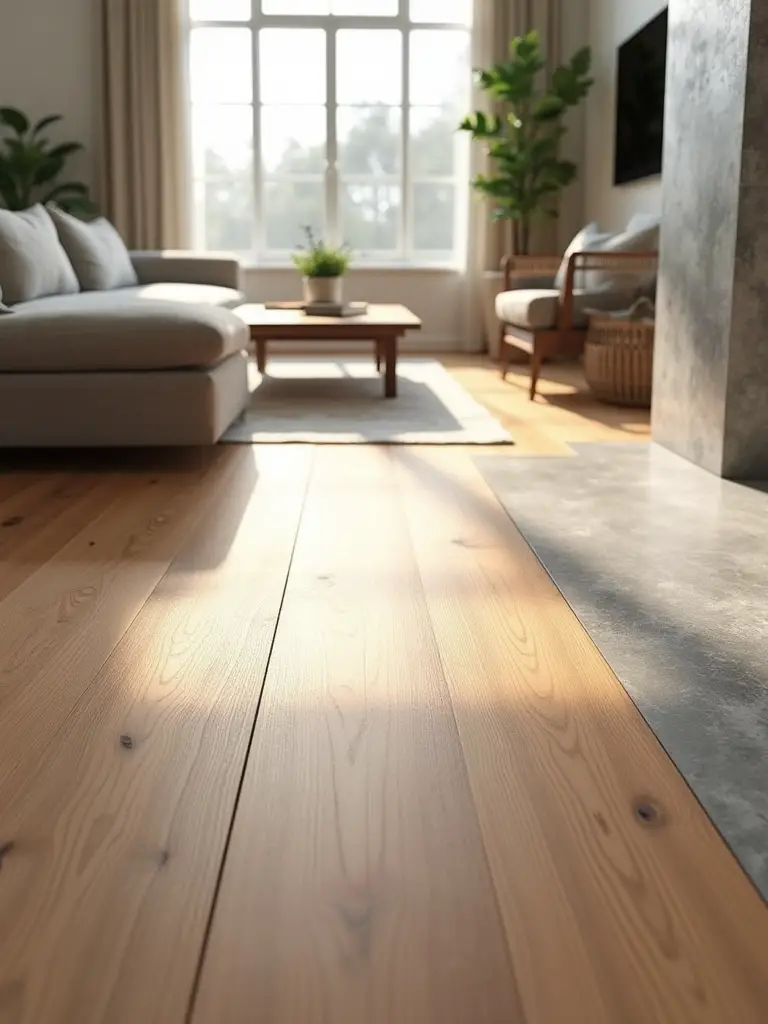
I recommend my clients spend a good chunk of their budget on quality flooring because it’s a pain to change later. Engineered hardwood is a great all-arounder—it gives you the look and feel of real wood but is more stable and often more durable. Luxury vinyl plank (LVP) has come a ridiculously long way; some of it looks so real it’s hard to tell the difference, and it’s practically indestructible. The key is to get something that supports your style but won’t become a high-maintenance headache you resent in six months.
Once your flooring is down, it’s time to soften it up and pull the room together with textiles.
9. Harmonize Textiles: Rugs, Curtains, and Upholstery Fabrics
This is what separates a sterile, showroom-like space from a room that feels like a home. Textiles—your rug, curtains, pillows, and throws—are the layers that add warmth, texture, and personality. The most common mistake here is buying a rug that’s too small. It looks like a sad little postage stamp floating in the middle of the room. A rug should be large enough that at least the front legs of all your main furniture pieces are sitting on it. This visually anchors the entire seating area and makes it feel cohesive.
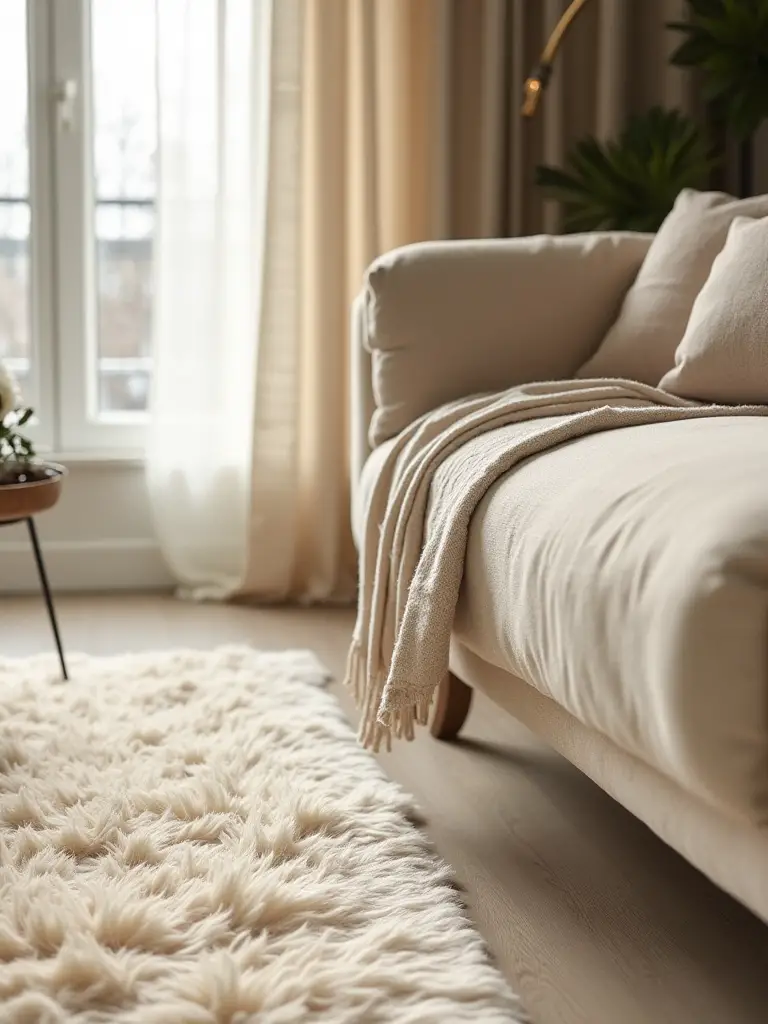
When it comes to curtains, hang them high and wide. Mount the curtain rod at least 4-6 inches above the window frame and extend it 6-10 inches on either side. This tricks the eye into thinking the window is bigger and the ceiling is higher. For upholstery, don’t be afraid to mix materials. A leather chair, a linen sofa, some velvet pillows, a chunky wool throw—that mix of textures is what creates a rich, visually interesting, and ridiculously comfortable space.
Bringing the Vision to Life: Key Furniture & Material Choices (Part 2)
We’ve got the main players in place. Now we need to direct the audience’s attention. A room without a focal point is like a story without a plot—it wanders aimlessly and fails to hold your interest. This is where we create a clear visual hierarchy that makes the room feel intentional and professionally designed.
10. Incorporate a Statement Artwork or a Defined Focal Point
Every great photograph has a clear subject. Every great room needs a focal point. This is the first thing your eye is drawn to when you walk in, and it anchors the entire space. In some rooms, it’s built-in, like a beautiful fireplace or a big window with a stunning view. If you have one of those, your job is easy: arrange your furniture to honor it. Don’t put the sofa in front of the gorgeous window or point all the chairs away from the fireplace.
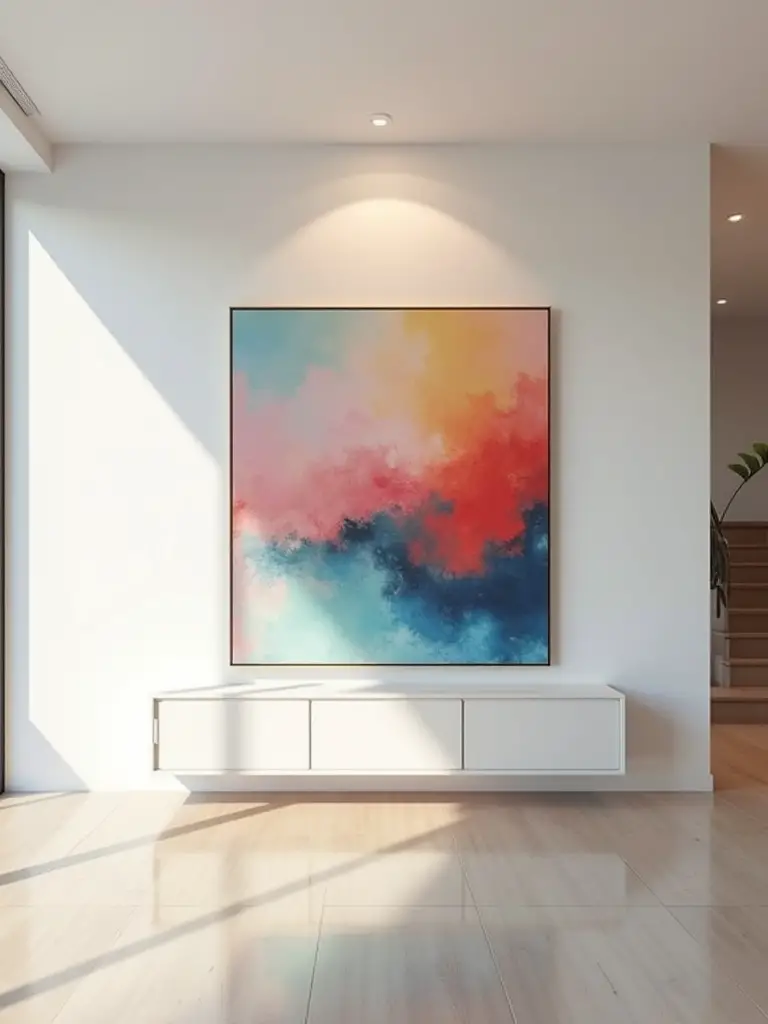
But what if you have a boring, boxy room with no Architectural features? You create a focal point. The easiest way is with a large piece of art. And I mean large. A common mistake is hanging a dinky little painting over a big sofa. As a rule of thumb, art above a sofa should be about two-thirds the width of the sofa itself. It sounds big, but it will look balanced. Don’t have the budget for a giant painting? A Gallery wall of smaller prints, a large-scale mirror, or even a bold, patterned accent wall can do the trick. The key is to be decisive and give the eye one main place to land.
Elevating the Space: Decorative Accents and Personal Touches (Part 1)
Now that the room has good bones—a solid layout, foundational furniture, and a clear focal point—it’s time to give it a soul. These are the final layers that tell the story of who lives here. This is where you move from a “designed” room to your room. Be careful though, this is also where things can quickly devolve into clutter if not done with intention.
11. Curate Meaningful Decor: Display Personal Collections Thoughtfully
Your shelves are not a warehouse for every knick-knack you’ve ever been given. They are a gallery. The key word here is curate. You have to be an editor. Pull out all your decorative objects—vases, sculptures, photos, souvenirs—and lay them out on the floor. Now, pick only the best. Keep the things that have a real story, that are truly beautiful, or that work with the color palette and style you established earlier. Put the rest away.
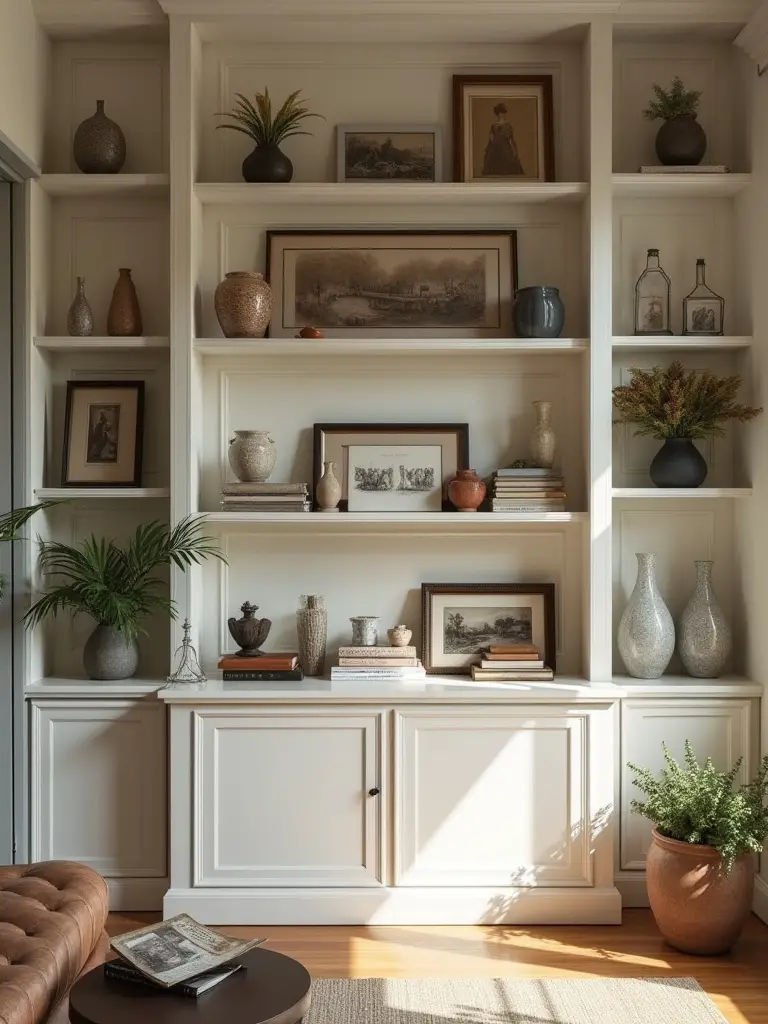
When you style your shelves, think in groupings. The “Rule of Three” is a designer’s old friend for a reason: objects grouped in odd numbers are more visually appealing. Vary the height and texture of the objects in your group. A tall vase, a short stack of books, and a small, sculptural object work well together. And please, leave some empty space. Negative space gives your cherished items room to breathe and makes them feel more important.
One of the most powerful and often overlooked decorative elements is something that’s alive, which brings us to the next point.
12. Introduce Greenery for Natural Vibrancy and Improved Air Quality
A room without a plant is a room that feels a little bit sad. I’m convinced of it. Greenery is the easiest, cheapest way to add life, color, and sculptural form to a space. Plants instantly soften hard corners and fill empty spaces with organic texture. From a photographer’s perspective, they break up the monotony of straight lines and boxy furniture. Plus, they literally clean the air you breathe.
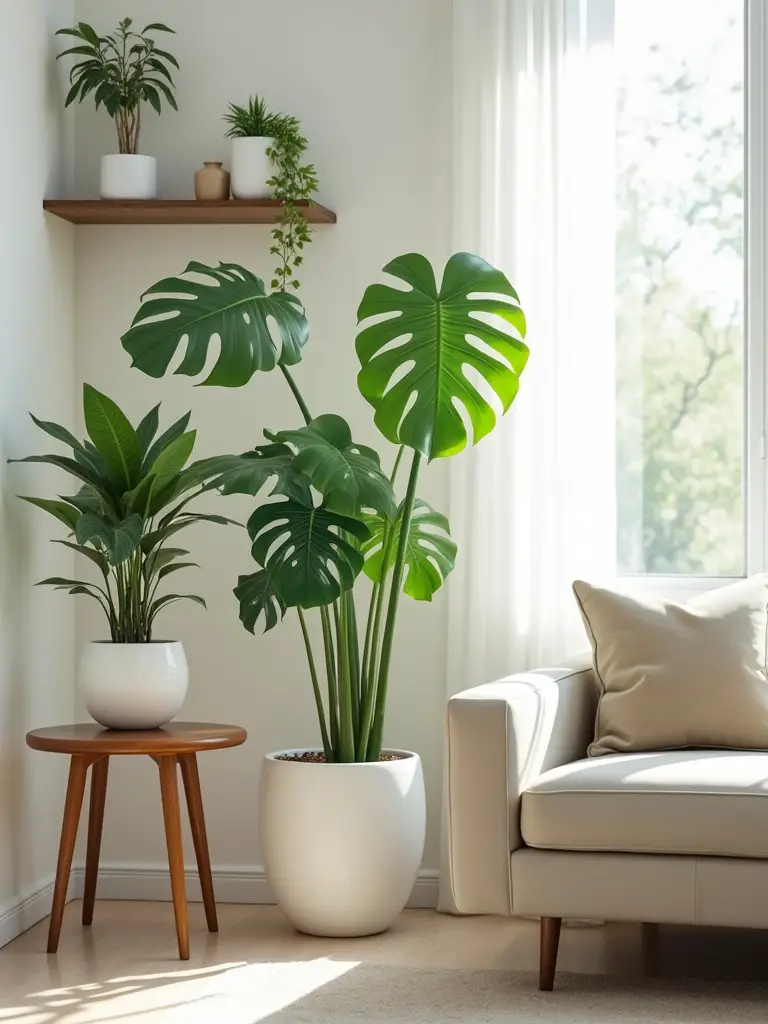
“But I kill every plant I own!” I hear you. Look, you just have to choose the right plant for the right spot. For low-light corners where everything else dies, get a snake plant or a ZZ plant. They thrive on neglect. For a spot with bright, indirect light, try a fiddle leaf fig for a big architectural statement or a pothos that you can let trail down a bookshelf. The key is picking plants that match your room’s light conditions and your level of commitment.
Next, we’ll talk about a professional secret for making a room feel expensive and custom-designed, even on a budget.
13. Mix Textures and Patterns for Dynamic Visual Interest
This is the shortcut to a high-end look. A room can be entirely neutral—all beige, gray, and white—but if it’s full of different textures, it will feel rich and sophisticated. A sterile room is often one-note, texturally speaking. Everything is smooth and flat. You need to intentionally layer in a variety of materials.
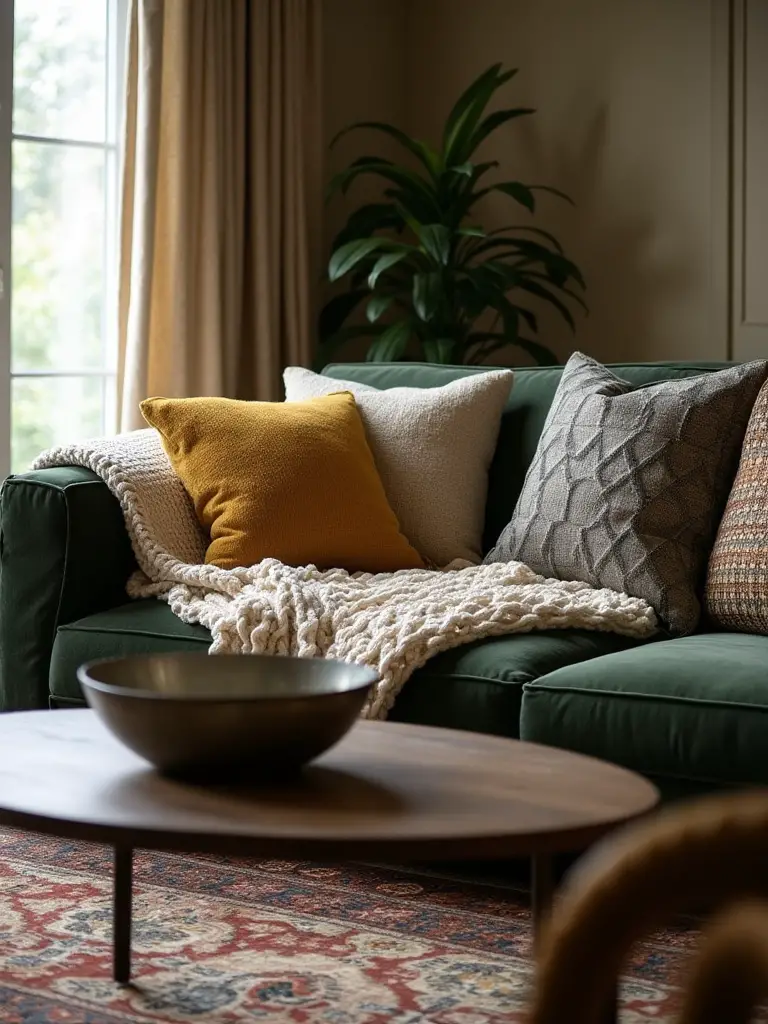
Think about a smooth leather armchair, a soft velvet pillow, a chunky knit throw, a rough-hewn wooden table, a sleek metal lamp, and a natural fiber rug. See how that combination creates instant depth? The same goes for patterns. The secret to mixing patterns without it looking like a chaotic mess is to vary the scale. Mix one large-scale pattern (like a bold floral on a pillow), one medium-scale pattern (like a stripe on a rug), and one small-scale pattern (like a subtle geometric on another pillow). As long as they share a common color, they’ll work together beautifully.
These textures and patterns need a home, and how you arrange them on your surfaces makes all the difference.
14. Style Shelves and Surfaces with Intention and Balance
We’ve already talked about curating what goes on your shelves, but how you arrange it is just as important. The goal is to create a series of balanced, interesting little scenes, or vignettes. Think of your bookshelf not as one big surface, but as a grid of smaller boxes. Style each box individually. On your coffee table and console tables, use trays to group objects. A tray instantly corralled a collection of small items—a candle, a small plant, a stack of coasters—and makes them feel like a single, intentional display.
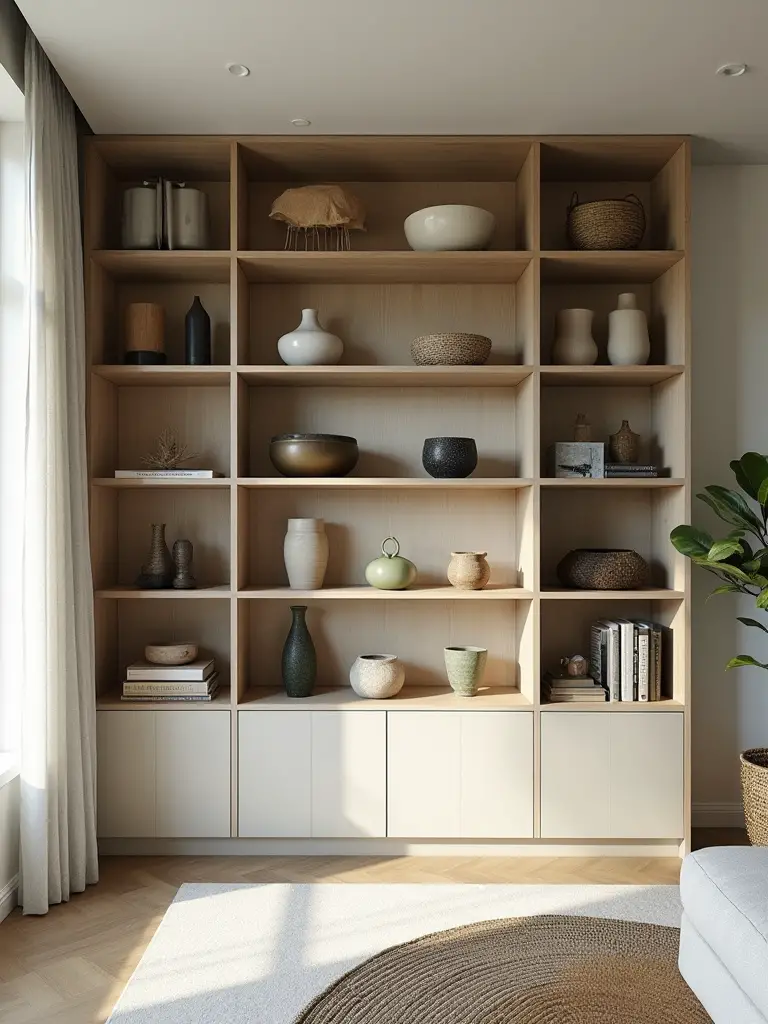
Use books to add height and create platforms for other objects. Stack a few horizontally and place a decorative box or bowl on top. Lean artwork against the back of a shelf instead of hanging everything. This creates a casual, layered look. Step back frequently and squint your eyes. Does the overall composition feel balanced? Is there a good mix of tall and short items, horizontal and vertical? Does your eye move around the display easily? It’s exactly like composing a photograph; you’re just doing it in three dimensions.
Elevating the Space: Decorative Accents and Personal Touches (Part 2)
We’re in the final stretch, focusing on the details that truly elevate a space from good to great. These are the professional-level tricks that manipulate light and sound to make a room not only look better but feel better. They’re subtle, but their impact is huge.
15. Employ Mirrors to Amplify Light and Perceived Space
This is the oldest trick in the designer’s handbook because it just plain works. A mirror is basically a window you can put anywhere. Placing a large mirror on a wall opposite a window is the classic move—it will bounce natural light all around the room, making it feel brighter and bigger. It can literally double the amount of light in a dark corner.
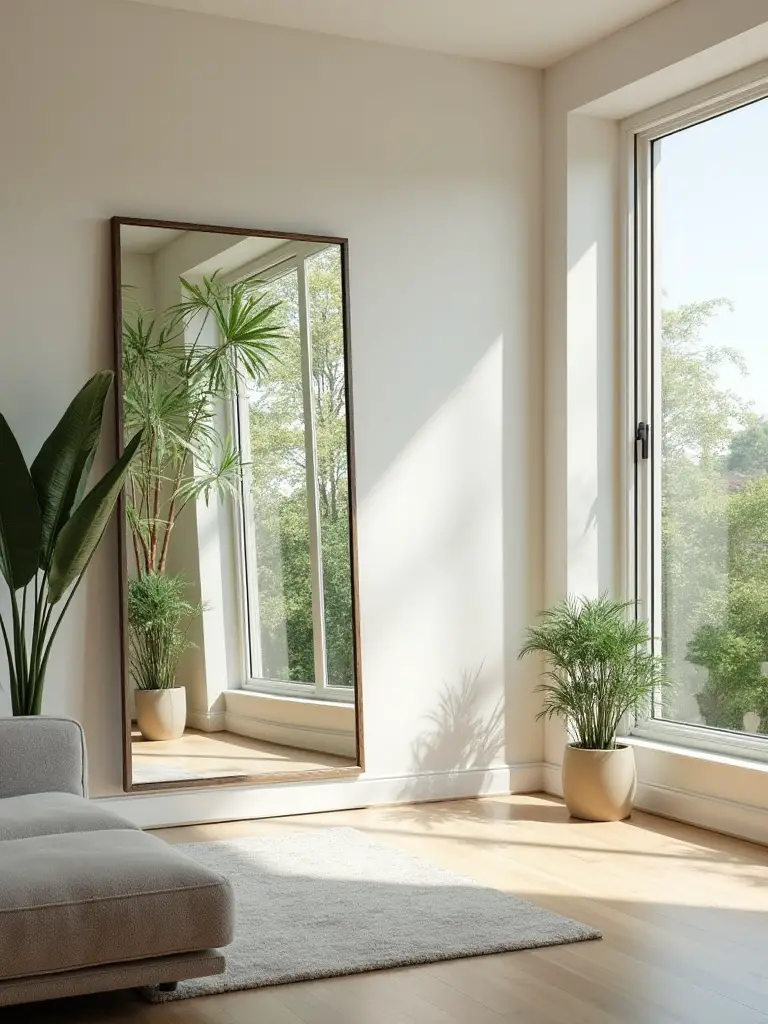
The key is placement and scale. Don’t hang a tiny mirror on a huge wall; it will look lost. Go as big as you can for the space. A large, full-length mirror leaned against a wall can create the illusion of a whole other room, dramatically increasing the perceived depth of the space. But be strategic about what it reflects. A mirror is only as good as the view it’s showing you. Make sure it reflects something beautiful, like that window, a great piece of art, or a chandelier—not a cluttered hallway or a blank wall.
Now for a sense that most people completely ignore when designing a room: hearing.
16. Optimize Acoustics for Comfort and Entertainment
Ever been in a living room that’s all hard surfaces—hardwood floors, leather sofa, glass coffee table—and noticed how loud and echoey it is? It’s unpleasant. Conversations feel harsh, the sound from the TV bounces all over the place, and it just doesn’t feel comfortable or relaxing. Good acoustics are a hidden component of a comfortable room.
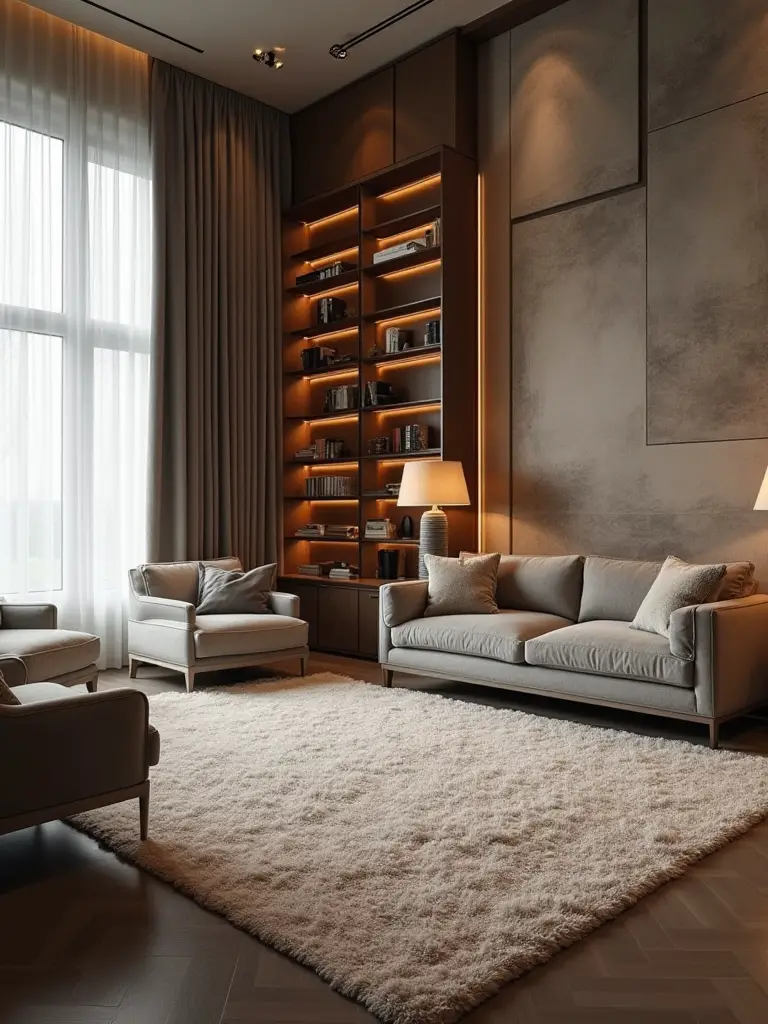
The solution is simple: add soft stuff. The more soft, sound-absorbing surfaces you have, the better. This is another reason a big area rug is non-negotiable on a hard floor. Thick curtains, upholstered furniture, throw pillows, and even a fabric wall hanging or a packed bookshelf will absorb sound and stop it from bouncing around. You’ll be amazed at how much more calming and pleasant the room feels when the sound is warm and muffled rather than sharp and echoey. It’s a subtle change with a massive psychological impact.
Refinement & Longevity: Advanced Tips for a Timeless Living Room (Part 1)
A truly successful design isn’t just about how a room looks on day one. It’s about how it works, adapts, and endures over time. These next steps are about future-proofing your living room—building in convenience, comfort, and flexibility that will serve you for years to come, making your investment a smart one.
17. Implement Smart Home Technology for Enhanced Convenience and Control
Look, smart home tech isn’t about turning your house into some sci-fi movie set. It’s about making your life easier and your room look cleaner. The best smart home integration is invisible. It’s about being able to press one button on your phone labeled “Movie Night” that dims the lights, lowers the shades, and turns on the TV. It’s about reducing clutter—fewer remotes, fewer ugly wall switches.
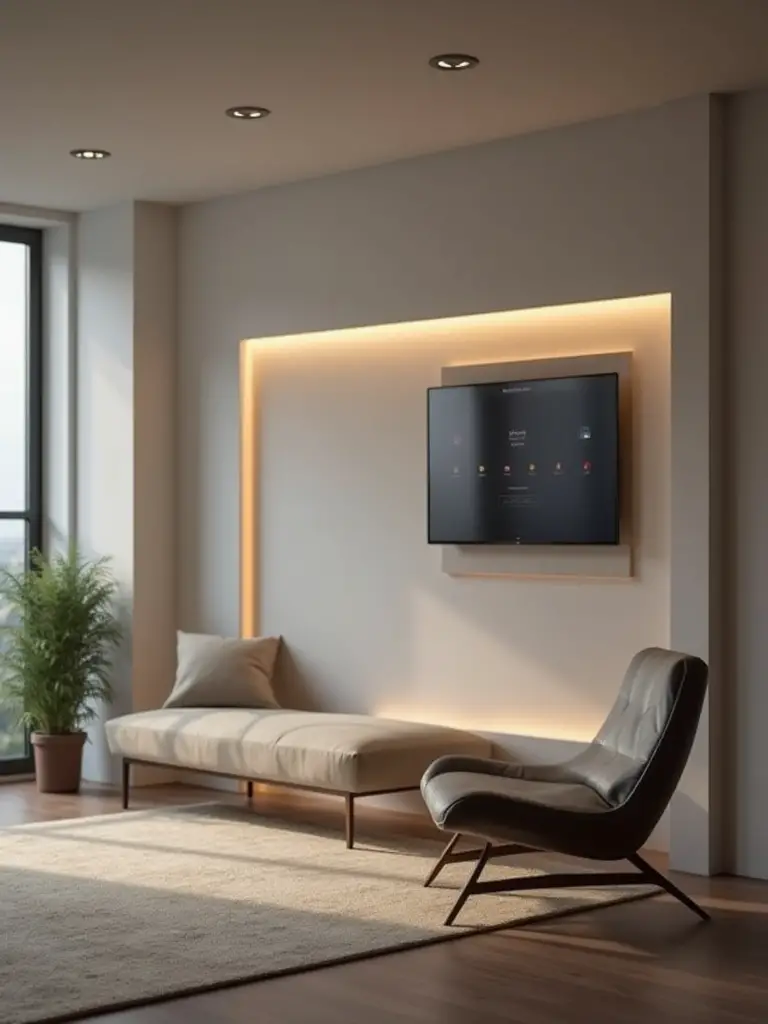
My advice is to start simple. Swap out your regular light bulbs for smart bulbs and replace your main light switches with smart dimmers. This gives you incredible control over your lighting layers with almost no effort. Smart plugs can make any lamp “smart.” A central hub like Google Home or Amazon Alexa can then tie it all together with voice commands. The goal isn’t technology for technology’s sake; it’s using tech to serve the function and aesthetic of the room seamlessly.
As important as tech is, never let it overshadow the most fundamental human need in a living room: genuine comfort.
18. Prioritize Ergonomics and Comfort in All Seating Arrangements
A beautiful chair that no one ever sits in because it’s horribly uncomfortable is not a chair; it’s a very expensive, and ultimately useless, sculpture. Comfort is not a luxury; it’s a primary function of living room seating. You have to physically test furniture before you buy it. I mean really test it. Go to the showroom and sit in that sofa for at least 15 minutes. Slouch a little. Put your feet up. Mimic how you’d actually use it at home.
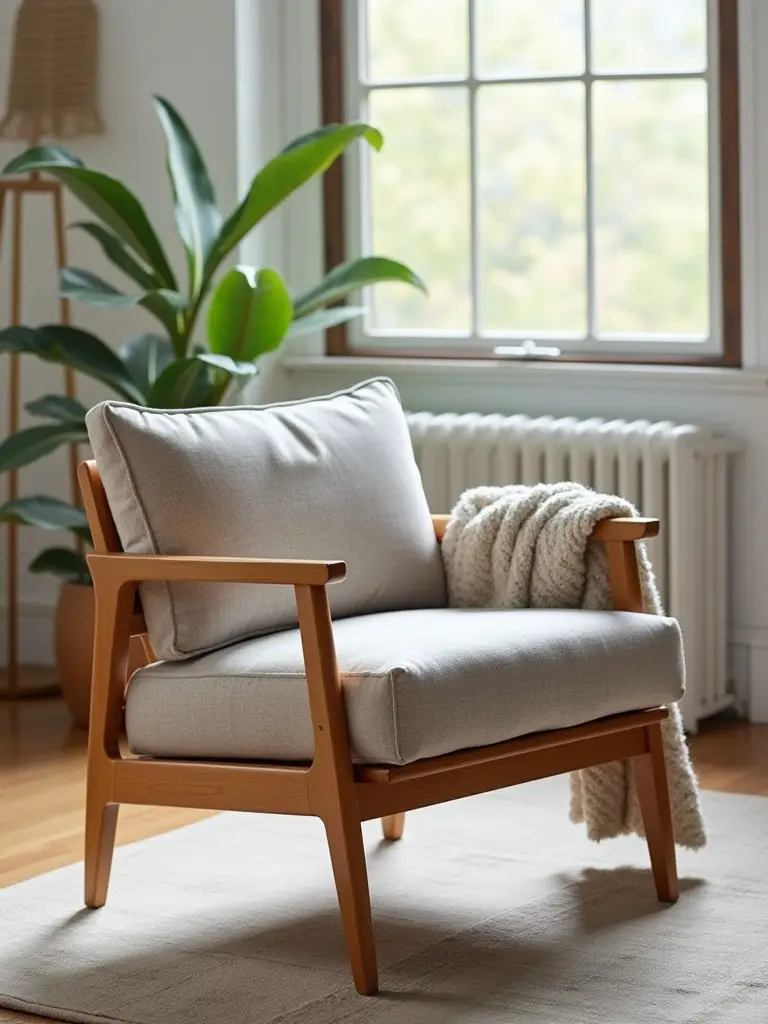
Look for a seat depth that lets you sit with your back against the cushion and your feet on the floor. For sofas, a medium-firm cushion will hold its shape and offer better support than something you sink into completely. Remember that “comfortable” is different for everyone. If you have family members with different needs, consider a modular sectional where some pieces can recline, or supplement with an ottoman that lets people put their feet up. A stunning room that you can’t wait to leave is a failed design.
Comfort today is one thing, but what about the life you’ll be living five years from now? That’s where adaptability comes in.
19. Design for Flexibility and Future Adaptability of Your Space
Your life isn’t static, so your living room shouldn’t be either. The way you use the space will change. Maybe you’ll have kids, or they’ll move out. You might start working from home more, or you might develop a new hobby. A well-designed living room has flexibility built in from the start.
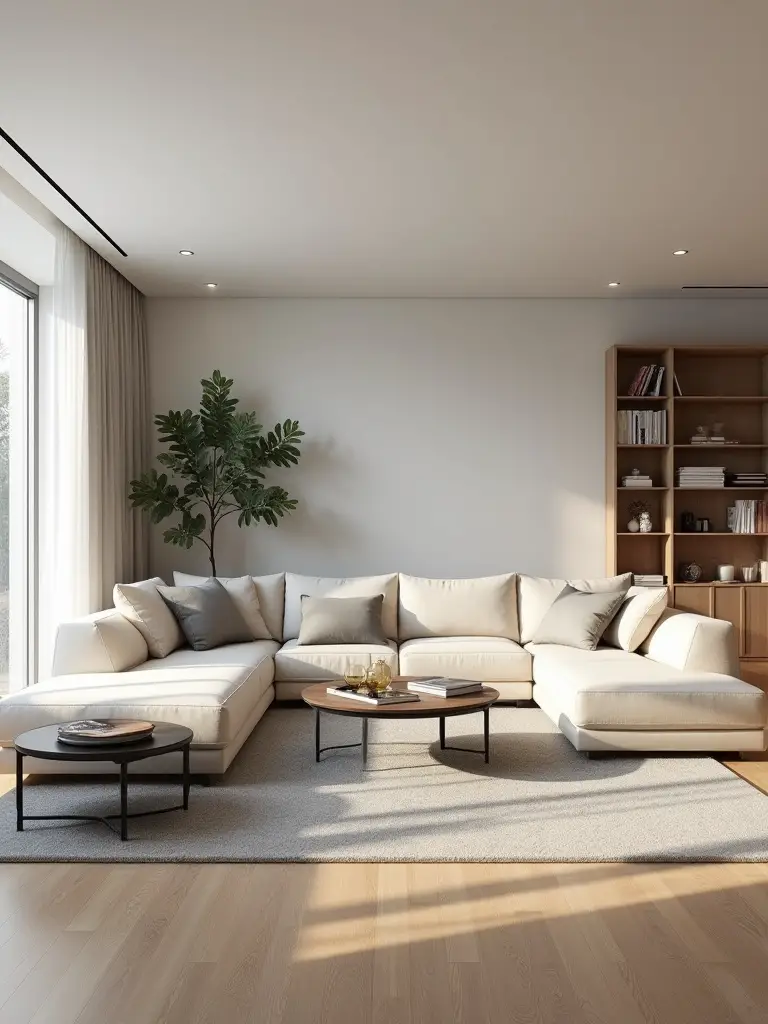
This is where modular and lightweight furniture is your best friend. A sectional sofa that can be reconfigured into different shapes is a brilliant investment. Nesting coffee tables can be pulled apart for guests and tucked away for daily life. An ottoman on casters can be rolled around as needed for extra seating or a footrest. And stick to a neutral, timeless base for your big, expensive items like the sofa and flooring. You can completely change the feel of the room over the years just by swapping out the cheaper stuff—pillows, rugs, art, and paint.
Flexibility is about making good choices upfront, and that includes learning from the common mistakes that trap people in cluttered spaces.
20. Address Common Living Room Layout Mistakes to Avoid Clutter
We’ve touched on this, but it bears repeating because it’s so important. The layout itself can be a source of clutter if it’s not right. The “bowling alley” living room is a classic mistake—a long, narrow room with a path right down the middle and furniture clinging to the walls. It feels awkward and messy. The solution is to float your furniture. Pull that sofa and chairs off the wall and group them in the middle of the room on a large rug to create an intentional, cozy zone. This leaves clear pathways along the walls.
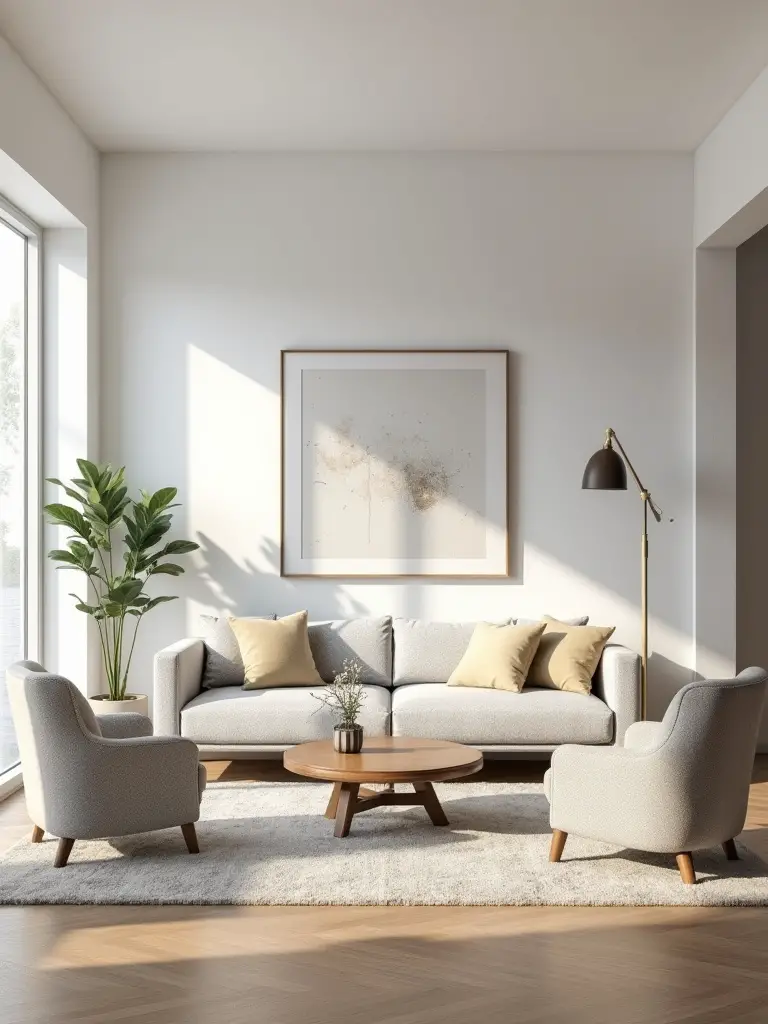
Another clutter-inducing mistake is using too many small pieces of furniture. A dozen small, dinky items will make a room feel way more cluttered than three or four larger, well-proportioned pieces. Edit down. Does that tiny side table really serve a purpose, or is it just another surface to collect junk? A layout should feel intentional and spacious, guiding you through the room and inviting you to sit down, not forcing you to navigate an obstacle course.
Refinement & Longevity: Advanced Tips for a Timeless Living Room (Part 2)
We’re at the final, crucial step. You’ve done all this work to create a beautiful, functional living room. Now, how do you keep it that way? A great design isn’t a one-and-done project; it’s a living thing that needs care and attention to look its best for the long haul.
21. Establish a Regular Maintenance Routine for Upholstery & Surfaces
This is the boring-but-essential secret to longevity. It’s not sexy, but it will save you thousands of dollars and keep your furniture looking new for years. You need a simple, consistent maintenance routine. Once a week, vacuum your upholstered furniture with the brush attachment. This prevents dust and dirt from grinding into the fibers and wearing them out prematurely. Once a month, rotate and flip your sofa cushions so they wear evenly.

Deal with spills immediately. Don’t let them sit. Blot, don’t rub. Have a specific, manufacturer-approved cleaner on hand for your fabric type. For wood surfaces, dust regularly with a microfiber cloth and use coasters. It’s a series of small, consistent actions that prevent big problems down the line. Treating your furniture with care is the final act of good design, ensuring the beautiful space you created actually lasts.
Conclusion
So there you have it. The 21 steps that take you from an empty (or cluttered) room to a living space that truly works. As you can see, it’s not about magic or some innate “good taste.” It’s a process. It’s about thinking strategically, being honest about your lifestyle, and making a series of intentional choices, from the big-picture layout to the tiny details of how you style a shelf.
Don’t let the number of steps intimidate you. Just start with number one. Define what you need the room to do, and let every other decision flow from there. Every small change—swapping out a rug that’s too small, adding a new lamp for a cozy reading corner, decluttering a single bookshelf—builds momentum. Imagine coming home at the end of the day not just to a house, but to a sanctuary. A room that looks fantastic, feels comfortable, and works perfectly for the life you actually live. That’s not a fantasy. It’s just good design. Go make it happen.
